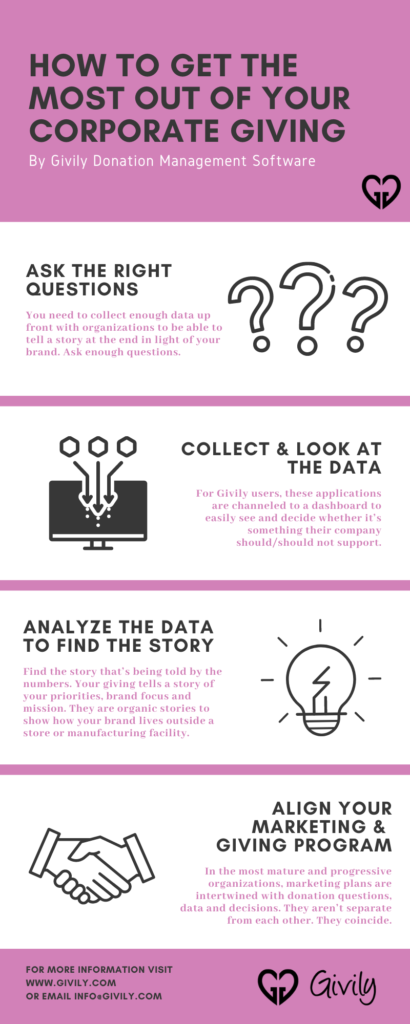
Have you seen the end of a toothpaste tube from someone who lived during the great depression? It’s flatter than a piece of paper. They have used every last ounce of toothpaste out of the tube. That’s a great picture of how to get the most out of your corporate giving.

When it comes to maximizing partnerships, whether they’re other peer company partnerships or community organizations or nonprofits, we leave so much on the table. Once you figure out how to be strategic, there are multiple depths of executing a strategy that help you maximize your corporate giving.
For example, let’s say you partner with a local grocery store to pick up their left over produce once a week. The partnership is a benefit to both parties. How could it be strategized better? Maybe the grocery store could share that they allow XYZ organization to pick up end of day donations on Thursdays and share some of the impact of that food donation. Is it in a newsletter or weekly shopper? What about putting it on a poster so that everyone who comes in the store starts off their shopping experience thinking of your generosity in the community?
But there are also there are six other days to the week which means six other organizations could benefit from the same type of end of day donation. By getting the news out on what you are donating, other organizations could be informed and benefit from your giving as well. As a bonus, you wouldn’t have to throw away any food at the end of the day in your store and you help the local community. And the local community helps you. Great partnership!
There are always multiple layers to strategizing
There are always multiple layers to strategizing, and continuing a partnership gives you opportunity to rework ideas, make it more efficient, and take another stab at the PR and marketing aspects of it. THAT is what is usually not maximized.
Let me repeat that again because it’s worth making a distinction. It’s not that the partnership or generosity isn’t maximized, it’s the efficiency of the transaction, the PR, social media, marketing and social impact conversations that aren’t maximized around giving. There is a lot left on the table here.
You’ve done the hardest part of creating the partnerships and coordinating a donation – now tell the story of what’s going on!
What keeps people from being able to talk about what’s going on?
Quite simply, most companies don’t collect enough information to be able to talk about their giving as a whole at the end of the year. That’s one of the things Givily’s software solves. People have random information on spreadsheets and it tells them nothing. It’s not a story and it’s hardly aggregated data from what I’ve seen.
Each request that comes in is a story.
Every partnership you create is a story.
And every partnership you create is a story.
You need to collect enough data up front with organizations to be able to tell a story at the end in light of your brand. Ask enough questions.
One of the solutions to not collecting enough information to be able to talk about your giving in a way that will resonate with your customers is to collect more data at the front end. Ask heaps of questions of those requesting something from your brand. Ask who they are, what they want, why they want it, why they chose your brand, what they’ll do if they are selected to receive a donation, etc.
Check out the way Clif Bar talks about their giving and how many questions they ask up front!
Our customers use a thorough application form to gather information when someone is asking for a donation which allows them to see right away if it’s an organization that aligns with their brand, and if it would be a beneficial partner. Once all these stories are compiled it’s a great mosaic of PR stories.
For Givily users, these applications are channeled to a dashboard to easily see and decide whether it’s something their company should/should not support.
It’s not good enough to collect data, the data has to be looked at!
Here are a handful of reasons data isn’t looked at in a company:
- It’s not collected
- It’s not aggregated
- The person managing the requests is a mid-level associate and is more focused on completing the work than analyzing the data for higher purposes.
- Marketing hasn’t realized/considered that heaps of customer data are being collected.
- 5. Marketing/Leadership doesn’t know how this data could benefit their brand.
I’ve yet to talk to a company who was collecting all the information they should have been from the beginning. Because the data wasn’t acquired, companies have nothing to aggregate and analyze.
So please, collect enough data, aggregate it, look at and analyze it. If that’s not your specialty, give it to someone in marketing who geeks out and tell them you have a lot of it that they may find interesting.
Analyze the data.
What do I mean by analyze the data? I want you to find the story that’s being told by the numbers.
Your giving tells a story of your priorities, brand focus and mission. It’s the perfect outworking of what you’re all about, or should be. They are organic stories to show how your brand lives outside a store or manufacturing facility.
If you leave the numbers alone and don’t aggregate them you can’t see the story. If you put the numbers together by category you’ll start to see some interesting facts. Pair interesting facts together and you start to develop a story.
In the most mature and progressive organizations, marketing plans are intertwined with donation questions, data and decisions. They aren’t separate from each other. They coincide. It’s one of the most important parts of maximizing corporate giving.
Based on what marketing is trying to do, community relations might add questions to their corporate giving form to gather data that would help marketing. With all the information that comes via a charitable request, it is aggregated so marketing can see if there’s a market segment developing, or an area they can pursue for more market share.
Make the approval process efficient and effective.
The transaction between company and organization has so many possible places to maximize. Making it more efficient to intake a request and look at it saves tons of time.
(60% time savings on average with Givily’s system.)
Aggregating and analyzing the data has its own magic of maximizing. Another place I find tremendous inefficiency is in the approval process. Get ready for an ugly statistic.
It takes 4-7 emails minimum to iron out the request details for an approved donation. 4-7! We’re talking 30+ minutes when you say yes. For those of you who have managed this process you know how time consuming it can be. It’s not that the work is difficult or unenjoyable, it’s just that it takes a lot of time, and typically it’s not the only thing on your plate.
Givily’s system uses templated approval emails with the ability to customize in order to significantly scale back the time in responding to requests.
A company doesn’t need a formal system to give a common response.
Especially when you’re sending a message of denial, you don’t need a formal system to get your common response narrowed down and saved somewhere on your computer. Copy and paste this into each email when denying and you’ll immediately experience a decrease in time spent. Please. Save HOURS by not writing each response individually.
Back to the approval emails. If you’re not using a formal donation request management system, approval emails will still take a good bit of time. Still, there are ways to have a simple format/template saved that you use every time you are approving a request so that you’re not rewriting an email several times a week.

If I were to summarize maximizing your corporate giving through this transaction it would be:
- Ask enough questions at the beginning Collect & aggregate the data
- Look at the data
- Find the story in your data
- Marry your marketing plans to your donation program
Download this image and share it with your coworkers! >>>
It’s time for a personal brainstorm on how to streamline this process. Get out a piece of paper. Draw out your current workflow of managing donation requests. (I’ll guide you below.)
- What points of entry do you have for your donation requests? Where do they go at their initial entry point?
- Who reviews them?
- How do they review them?
- Who approves them?
- Who responds to the requestor?
- How does your company fulfill requests?
- How are you tracking these details?
- Where are you reviewing your data?
- How are you making plans to intertwine your marketing and donation program?
You should end up with a lot of lines moving from left to right, maybe some boxes. Take a look at that thing! Hopefully, it provides a bit of clarity seeing your process drawn out. It should also reveal some areas of inefficiency.
Circle the area that needs the most improvement. (Some of you are contemplating how to circle the entire page!)
Spend the next few minutes drafting a list of changes to be made to this area. Once you have your list of changes, get busy about making improvements.
Allot time on your calendar to complete these improvements. I can’t tell you how many times I’ve seen a list drafted with inspiration and full intention to tackle, but it never happened because the tasks never received proper calendar time. Commit to making the changes in a calendar.
If you’re looking at your current workflow and wondering what Givily might offer to you and your company, please don’t hesitate to reach out. We would love to help your maximize your corporate giving by streamlining the process! Send us an email at info@givily.com. We look forward to hearing from you!
